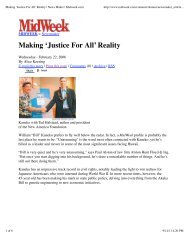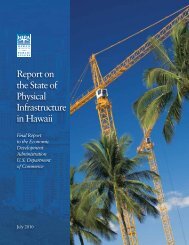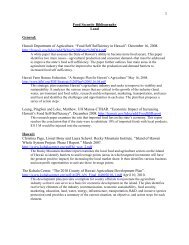Hawai'i Fisheries Initiative - The Hawaii Institute for Public Affairs
Hawai'i Fisheries Initiative - The Hawaii Institute for Public Affairs
Hawai'i Fisheries Initiative - The Hawaii Institute for Public Affairs
Create successful ePaper yourself
Turn your PDF publications into a flip-book with our unique Google optimized e-Paper software.
State of Hawai‘i <strong>Fisheries</strong> Programs<br />
Goals <strong>for</strong> State <strong>Fisheries</strong> Management<br />
DAR’s 2006 report to the state legislature<br />
set out a series of near-term goals:<br />
n Evaluate and amend administrative<br />
rules covering fisheries management<br />
methods, such as closed seasons,<br />
bag limits, minimum sizes, gear restrictions,<br />
and total harvest limits<br />
n Establish measures to deal with aquatic<br />
alien species introduced through ship<br />
ballast water and hull fouling; improve<br />
the invasive species response and<br />
management plans<br />
n Increase community involvement in an<br />
advisory capacity<br />
n Work with the <strong>Hawaii</strong>an community to<br />
develop protocols <strong>for</strong> sustainable traditional<br />
and cultural fishing practices<br />
n Expand the recreational fish catch<br />
surveys statewide<br />
n Expand stock-enhancement programs,<br />
including the artificial reef program 180<br />
n Expand aquatic education and<br />
outreach ef<strong>for</strong>ts statewide to raise<br />
awareness of fisheries management<br />
issues and opportunities<br />
DAR’s programs cover a wide range of<br />
activities in near-shore areas (the state’s<br />
0-3 nm zone): fish and habitat surveys,<br />
artificial reef installations (both shallow<br />
and deeper water <strong>for</strong> bottomfish habitat),<br />
fish aggregation devices, education/<br />
training, commercial fisher licensing, the<br />
recreational fishers survey, and identifying<br />
and implementing Marine Life Conservation<br />
Districts (MLCDs), which limit or prohibit<br />
fishing and other activities in specified<br />
marine areas. 181<br />
O‘ahu’s Hanauma Bay became the state’s first<br />
MLCD 40 years ago. 182 Many early MLCDs were<br />
established with conservation and education<br />
in mind, rather than to enhance fish stocks; this<br />
resulted in MLCDs that vary in size, habitat<br />
quality, and management systems. A NOAA<br />
study released in March 2007 confirms that<br />
MLCDs that prohibit all fishing activity show<br />
higher fish biomass, larger overall fish sizes,<br />
and higher biodiversity than similar adjacent<br />
marine habitat areas. Areas with rotating<br />
closures do not appear to be effective as a<br />
stock-enhancement tool.<br />
46







